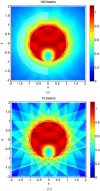The number of beams in IMRT--theoretical investigations and implications for single-arc IMRT
- PMID: 19949256
- PMCID: PMC3142715
- DOI: 10.1088/0031-9155/55/1/006
The number of beams in IMRT--theoretical investigations and implications for single-arc IMRT
Abstract
The first purpose of this paper is to shed some new light on the old question of selecting the number of beams in intensity-modulated radiation therapy (IMRT). The second purpose is to illuminate the related issue of discrete static beam angles versus rotational techniques, which has recently re-surfaced due to the advancement of volumetric modulated arc therapy (VMAT). A specific objective is to find analytical expressions that allow one to address the points raised above. To make the problem mathematically tractable, it is assumed that the depth dose is flat and that the lateral dose profile can be approximated by polynomials, specifically Chebyshev polynomials of the first kind, of finite degree. The application of methods known from image reconstruction then allows one to answer the first question above as follows: the required number of beams is determined by the maximum degree of the polynomials used in the approximation of the beam profiles, which is a measure of the dose variability. There is nothing to be gained by using more beams. In realistic cases, in which the variability of the lateral dose profile is restricted in several ways, the required number of beams is of the order of 10-20. The consequence of delivering the beams with a 'leaf sweep' technique during continuous rotation of the gantry, as in VMAT, is also derived in an analytical form. The main effect is that the beams fan out, but the effect near the axis of rotation is small. This result can serve as a theoretical justification of VMAT. Overall the analytical derivations in this paper, albeit based on strong simplifications, provide new insights into, and a deeper understanding of, the beam angle problem in IMRT. The decomposition of the beam profiles into well-behaved and easily deliverable smooth functions, such as Chebyshev polynomials, could be of general interest in IMRT treatment planning.
Figures





Similar articles
-
FusionArc optimization: a hybrid volumetric modulated arc therapy (VMAT) and intensity modulated radiation therapy (IMRT) planning strategy.Med Phys. 2013 Jul;40(7):071713. doi: 10.1118/1.4808153. Med Phys. 2013. PMID: 23822417 Free PMC article.
-
A comprehensive formulation for volumetric modulated arc therapy planning.Med Phys. 2016 Jul;43(7):4263. doi: 10.1118/1.4953832. Med Phys. 2016. PMID: 27370141 Free PMC article.
-
Volumetric modulated arc therapy: planning and evaluation for prostate cancer cases.Int J Radiat Oncol Biol Phys. 2010 Apr;76(5):1456-62. doi: 10.1016/j.ijrobp.2009.03.033. Epub 2009 Jun 18. Int J Radiat Oncol Biol Phys. 2010. PMID: 19540062
-
[Which IMRT? From "step and shoot" to VMAT: physicist point of view].Cancer Radiother. 2010 Oct;14(6-7):539-49. doi: 10.1016/j.canrad.2010.06.012. Epub 2010 Aug 21. Cancer Radiother. 2010. PMID: 20728394 Review. French.
-
Potential advantages of volumetric arc therapy in head and neck cancer.Head Neck. 2015 Jun;37(6):909-14. doi: 10.1002/hed.23685. Epub 2014 Apr 30. Head Neck. 2015. PMID: 24623665 Review.
Cited by
-
Robotic ultrasound-guided SBRT of the prostate: feasibility with respect to plan quality.Int J Comput Assist Radiol Surg. 2017 Jan;12(1):149-159. doi: 10.1007/s11548-016-1455-7. Epub 2016 Jul 12. Int J Comput Assist Radiol Surg. 2017. PMID: 27406743
-
Two-step intensity modulated arc therapy (2-step IMAT) with segment weight and width optimization.Radiat Oncol. 2011 Jun 2;6:57. doi: 10.1186/1748-717X-6-57. Radiat Oncol. 2011. PMID: 21631957 Free PMC article.
-
Single-arc volumetric-modulated arc therapy can provide dose distributions equivalent to fixed-beam intensity-modulated radiation therapy for prostatic irradiation with seminal vesicle and/or lymph node involvement.Br J Radiol. 2012 Mar;85(1011):231-6. doi: 10.1259/bjr/94843998. Epub 2011 Jun 28. Br J Radiol. 2012. PMID: 21712428 Free PMC article.
-
Comparison of non-coplanar optimization of static beams and arc trajectories for intensity-modulated treatments of meningioma cases.Phys Eng Sci Med. 2021 Dec;44(4):1273-1283. doi: 10.1007/s13246-021-01061-8. Epub 2021 Oct 7. Phys Eng Sci Med. 2021. PMID: 34618329 Free PMC article.
-
Fast IMRT by increasing the beam number and reducing the number of segments.Radiat Oncol. 2011 Dec 9;6:170. doi: 10.1186/1748-717X-6-170. Radiat Oncol. 2011. PMID: 22152490 Free PMC article.
References
-
- Bortfeld T, Oelfke U. Fast and exact 2D image reconstruction by means of Chebyshev decomposition and backprojection. Phys. Med. Biol. 1999;44:1105–20. - PubMed
-
- Bortfeld T, Oelfke U, Nill S. What is the optimum leaf width of a multileaf collimator? Med. Phys. 2000;27:2494–502. - PubMed
-
- Bortfeld T, Webb S. Single-arc IMRT? Phys. Med. Biol. 2009;54:N9–20. - PubMed
-
- Boyer AL, Ochran TG, Nyerick CE, Waldron TJ, Huntzinger CJ. Clinical dosimetry for implementation of a multileaf collimator. Med. Phys. 1992;19:1255–61. - PubMed
-
- Cameron C. Sweeping-window arc therapy: an implementation of rotational IMRT with automatic beam-weight calculation. Phys. Med. Biol. 2005;50:4317–36. - PubMed
MeSH terms
Grants and funding
LinkOut - more resources
Full Text Sources
